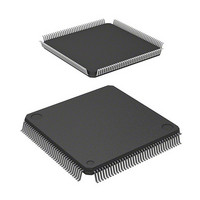HD6417708RF100A Renesas Electronics America, HD6417708RF100A Datasheet - Page 251

HD6417708RF100A
Manufacturer Part Number
HD6417708RF100A
Description
IC SUPERH MPU ROMLESS 144LQFP
Manufacturer
Renesas Electronics America
Series
SuperH® SH7700r
Datasheet
1.HD6417708SF60V.pdf
(635 pages)
Specifications of HD6417708RF100A
Core Processor
SH-2
Core Size
32-Bit
Speed
100MHz
Connectivity
EBI/EMI, SCI, SmartCard
Peripherals
POR, WDT
Number Of I /o
8
Program Memory Type
ROMless
Voltage - Supply (vcc/vdd)
3.15 V ~ 3.6 V
Oscillator Type
External
Operating Temperature
-20°C ~ 75°C
Package / Case
144-LQFP
Lead Free Status / RoHS Status
Contains lead / RoHS non-compliant
Eeprom Size
-
Ram Size
-
Program Memory Size
-
Data Converters
-
Available stocks
Company
Part Number
Manufacturer
Quantity
Price
Company:
Part Number:
HD6417708RF100A
Manufacturer:
Renesas Electronics America
Quantity:
10 000
Part Number:
HD6417708RF100A
Manufacturer:
HITACHI/日立
Quantity:
20 000
Part Number:
HD6417708RF100AV
Manufacturer:
RENESAS/瑞萨
Quantity:
20 000
- Current page: 251 of 635
- Download datasheet (3Mb)
Area 5: Area 5 physical address bits A28–A26 are 101. Address bits A31–A29 are ignored and
the address range is the 64 Mbytes at H'14000000 + H'20000000
H'20000000
Normal memories like SRAM and ROM as well as burst ROM and PCMCIA interfaces can be
connected to this space. PCMCIA interfaces only use their IC memory card interface, so the
address range becomes the 32 Mbytes at H'14000000 + H'20000000 n – H'15FFFFFF +
H'20000000
For normal memory and burst ROM, byte, word, or longword can be selected as the bus width
using the A5SZ1–A5SZ0 bits in BCR2. For the PCMCIA interface, byte, and word can be
selected as the bus width using the A5SZ1–A5SZ0 bits in BCR2.
When the area 5 space is accessed and normal memory is connected, the CS5 signal is asserted.
The RD signal that can be used as OE and the WE0–WE3 signals for write control are also
asserted. When the PCMCIA interface is used, the CE1 signal, CE2 signal, OE signal, and WE
signal are asserted.
The number of bus cycles is selected between 0 and 10 wait cycles using the A5W2–A5W0 bits in
WCR2. Also, any number of waits can be inserted in each bus cycle by means of the external wait
pin (WAIT). When a burst function is used, the bus cycle pitch of the burst cycle is determined
within a range of 2–10 according to the number of waits. The setup and hold times of
address/CE1A/CE2A for the read/write strobe signals can be set within a range of 0.5–3.5 cycles
using the A5TED1–A5TED0 and A5TEH1–A5TEH0 bits in the PCR register.
Area 6: Area 6 physical address bits A28–A26 are 110. Address bits A31–A29 are ignored and
the address range is the 64 Mbytes at H'18000000 + H'20000000
H'20000000
Normal memories like SRAM and ROM as well as burst ROM and PCMCIA interfaces can be
connected to this space. When the PCMCIA interface is used, the IC memory card interface
address range is the 32 Mbytes at H'18000000 + H'20000000
n and the I/O card interface address range is the 32 Mbytes at H'1A000000 + H'20000000 n –
H'1BFFFFFF + H'20000000 n (n = 0–6, n = 1–6 is the shadow space).
For normal memory and burst ROM, byte, word, or longword can be selected as the bus width
using the A6SZ1–A6SZ0 bits in BCR2. For the PCMCIA interface, byte, and word can be
selected as the bus width using the A6SZ1–A6SZ0 bits in BCR2.
When the area 6 space is accessed and normal memory is connected, the CS6 signal is asserted.
The RD signal that can be used as OE and the WE0–WE3 signals for write control are also
asserted. When the PCMCIA interface is used, the CE1B signal, CE2B signal, OE signal, and
WE1 , ICORD, and ICOWR signals are asserted.
n (n = 0–6, n = 1–6 is the shadow space).
n (n = 0–6, n = 1–6 is the shadow space).
n (n = 0–6, n = 1–6 is the shadow space).
n – H'19FFFFFF + H'20000000
n – H'17FFFFFF +
n – H'1BFFFFFF +
231
Related parts for HD6417708RF100A
Image
Part Number
Description
Manufacturer
Datasheet
Request
R

Part Number:
Description:
KIT STARTER FOR M16C/29
Manufacturer:
Renesas Electronics America
Datasheet:

Part Number:
Description:
KIT STARTER FOR R8C/2D
Manufacturer:
Renesas Electronics America
Datasheet:

Part Number:
Description:
R0K33062P STARTER KIT
Manufacturer:
Renesas Electronics America
Datasheet:

Part Number:
Description:
KIT STARTER FOR R8C/23 E8A
Manufacturer:
Renesas Electronics America
Datasheet:

Part Number:
Description:
KIT STARTER FOR R8C/25
Manufacturer:
Renesas Electronics America
Datasheet:

Part Number:
Description:
KIT STARTER H8S2456 SHARPE DSPLY
Manufacturer:
Renesas Electronics America
Datasheet:

Part Number:
Description:
KIT STARTER FOR R8C38C
Manufacturer:
Renesas Electronics America
Datasheet:

Part Number:
Description:
KIT STARTER FOR R8C35C
Manufacturer:
Renesas Electronics America
Datasheet:

Part Number:
Description:
KIT STARTER FOR R8CL3AC+LCD APPS
Manufacturer:
Renesas Electronics America
Datasheet:

Part Number:
Description:
KIT STARTER FOR RX610
Manufacturer:
Renesas Electronics America
Datasheet:

Part Number:
Description:
KIT STARTER FOR R32C/118
Manufacturer:
Renesas Electronics America
Datasheet:

Part Number:
Description:
KIT DEV RSK-R8C/26-29
Manufacturer:
Renesas Electronics America
Datasheet:

Part Number:
Description:
KIT STARTER FOR SH7124
Manufacturer:
Renesas Electronics America
Datasheet:

Part Number:
Description:
KIT STARTER FOR H8SX/1622
Manufacturer:
Renesas Electronics America
Datasheet:

Part Number:
Description:
KIT DEV FOR SH7203
Manufacturer:
Renesas Electronics America
Datasheet:











